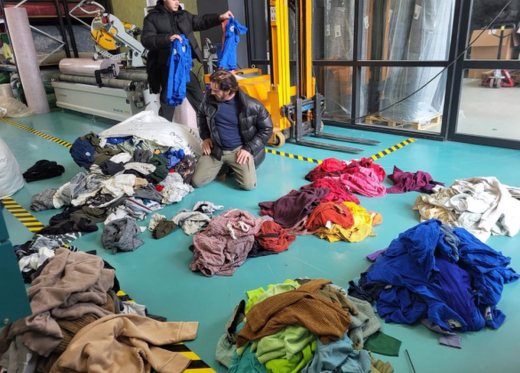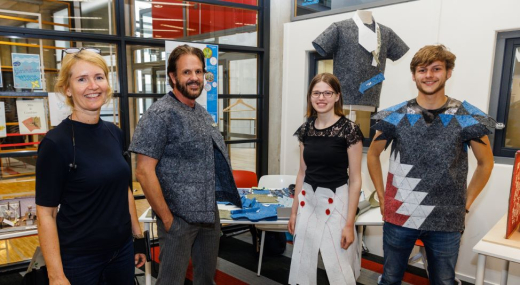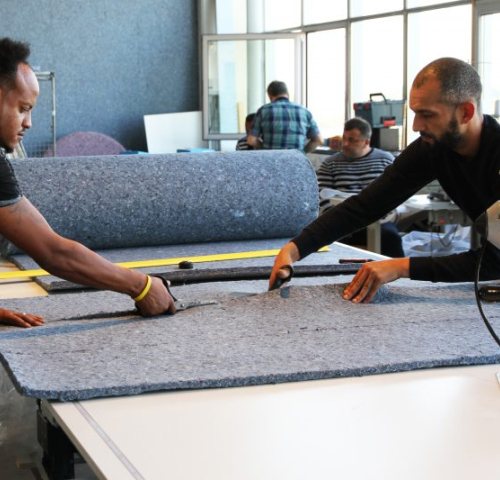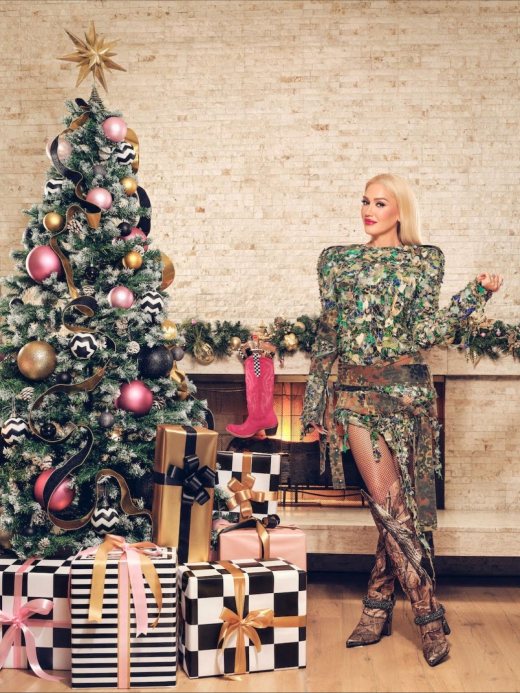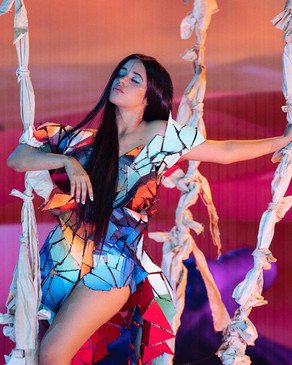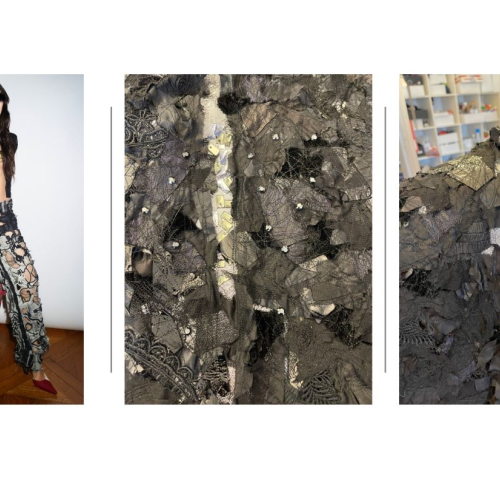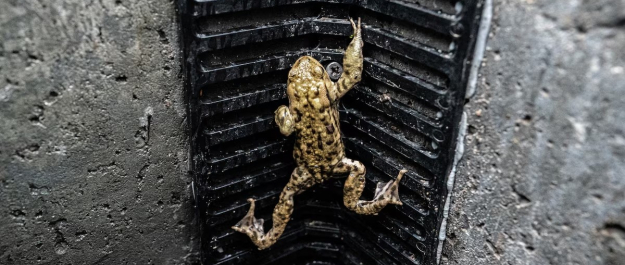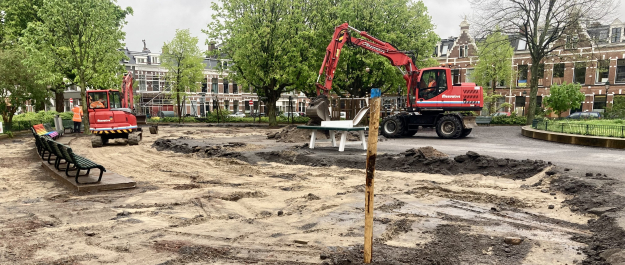Van der Kemp’s designs are the preliminary highlight of the Trashure project. This attempts to put an end to the enormous mountain of textile waste that Dutch and European consumers throw away every year. How? By recycling the textile waste and using it again for new fashion and clothing.
The project is a collaboration between the famous fashion designer, students from The Hague University of Applied Sciences led by sustainable fashion expert Professor Dr. Kim Poldner, textile collector Sympany and social recycling company i-did.
Première Vision Paris
The main purpose: to market a fabric made from felt from recycled textile waste that fashion companies such as H&M will use for their clothing. The initiators have already noted the place and time of the launch of that fabric in their agenda: Première Vision in Paris, from 2 to 4 July, the largest fashion fabric fair in the world. “What we focus on with Trashure is mainly textile waste. Currently, 1 percent of textiles are made from recycled material. This must increase significantly, because the Dutch government wants to be completely circular by 2050. We are looking if we can launch felt as a marketable, wearable fabric,” says Poldner, the driving force behind the project.
Turning waste into worth
Trashure is financed by the Netherlands Enterprise Agency (RVO) through the knowledge and Innovation Agenda Circular Economy (KIA CE). i-did is the hub in Trashure. The company opened a textile recycling factory in May 2022 in The New Farm in The Hague, a collective building for innovative, social and circular manufacturing companies. In a large hall on the ground floor, two long rows of machines are now lined up in a recycling street. Textile waste collected and delivered by Sympany goes in at the front. Mostly broken pieces of textile, old jeans and worn-out work clothes.
“We can process the lowest quality textile waste, which is normally incinerated.”
From bags to pillows
At the end of the recycling street, rolls of felt come out of the machines: i-felt. A strong design material that feels soft and has the same color as the original textile. The felt is processed upstairs in the studio into bags, planters, curtains, slats, cushions, laptop covers, acoustic panels and many other items.
Social and sustainable mission
The work is done by long-term unemployed people who use it as a springboard to a new job. Since its start in 2009, i-did has helped almost 500 people on social assistance or other benefits to find work. “That social purpose is our primary mission. What we do around sustainability is super important and is our secondary mission,” Schilizzi explains. According to Poldner, this combination is what makes the company so special. She wrote a teaching case about it entitled ‘i-did: social impact through circular business’. “That is used in business schools all over the world,” she says.
Sustainable fashion pioneer
i-did shows that low-quality textile waste can still be recycled. But the big question until now has been: can you also use it to make textiles for clothing? Something people want to wear? That’s what Trashure wants to demonstrate. Ronald van der Kemp initiated the project when he approached i-did three years ago because he wanted to start working with recycled felt. The Dutchman works with leftover residual materials - so-called deadstock - and recycled material. In 2014, he launched the world’s first sustainable couture label RVDK. Van der Kemp is seen as a sustainable pioneer in the international fashion industry. He wants to show the world that ethical fashion can also be glamorous and exciting. His creations are worn by celebrities such as Gwen Stefani, Céline Dion, Katy Perry and Michelle Obama.
Gwen Stefani in Vogue
In 2021, Van der Kemp experimented with felt from i-did for the first time. He made a felt corset in which pop star Gwen Stefani had her picture taken for fashion magazine Vogue. Poldner then joined in and - together with i-did - approached the other partners in the project, like Sympany. Felt is now mainly used in cars, as insulation material and for cleaning cloths. i-did is the first company to turn it into a design fabric for bags, accessories and interior products. “Felt still has a dusty image in the Netherlands. In this project we wanted to see if it could be made into something wearable,” says Schilizzi.
Awareness through celebrities
Van der Kemp started with accessories such as hats and necklaces from i-felt. He showed his first dress made with felt from i-did during the Paris couture weeks in July 2021. It was later exhibited as a museum piece. In recent couture weeks, the fashion designer has shown clothing from felt more often. They are also showed by celebrities. In May 2022, Cuban-American singer Camila Cabello wore an i-did felt dress during the presentation of her new album on TikTok. She has 66.5 million followers on Instagram alone. Last Christmas, pop star Gwen Stefani - 17.6 million followers - wore a special Trashure dress from pieces of textile waste, designed by Van der Kemp. “Through this kind of exposure you create awareness among an entire generation and make it open to discussion,” says Poldner. “Ronald shows that sustainable and recycled textiles can be fashionable.”
Statement bags
In November 2022, Van der Kemp and i-did jointly launched thirteen so-called statement bags. As a protest against the overflowing textile mountain. “They were sold out on the release date. For the project, that was a kind of try-out on how something like this works,” Poldner says.
Fight for circular fashion
As a serial entrepreneur and researcher, Poldner has been fighting for a more circular and sustainable fashion industry since twenty years. She founded the Circular Fashion Lab at Wageningen University & Research (WUR) in 2017. Since 2019, she is professor of Circular Business at The Hague University of Applied Sciences and as of January 1, 2024 she has also been appointed special chair Regional and Circular Economic Development at the University of Groningen (RUG). At the end of last year she published the book ‘Love Letters to my Clothes’. An intimate book about revaluing discarded clothing.
“The clothing industry is one of the most polluting sectors in the world with 10 percent of global CO2 emissions.”
Polluting industry
The figures about this are clear. One T-shirt requires 2,700 liters of water, textile dyeing causes 20 percent of all water pollution and polyester particles released during washing end up as microplastics in the oceans and also in people’s blood via the consumption of fish. In the Netherlands, more than 300 million kilos of textile waste end up in the incinerator every year. That’s why, after the Netherlands, the entire EU is introducing the so-called Extended Product Responsibility (UPV). This obliges manufacturers to collect used textiles so that three quarters can be recycled by 2030.
On the catwalk in July
Ronald van der Kemp will present designs made from Trashure felt again during the Paris couture week in July. “Then the development of the material is one step further. I wanted to use it in my show in January, but we weren’t ready yet,” he says.
“The great thing about Trashure is the whole story behind it. That you can make very beautiful things from something that is actually discarded. We have proved that every single time during the couture weeks, but I’m always trying to go one step further. The celebrities are ambassadors for this. They help spread the story and hopefully make people think differently about sustainability, because they can see it in a more glamorous way.”
Business case for sustainable fashion
Van der Kemp is a fantastic billboard for Trashure and i-did, but the project has not generated much revenue so far. A business case is needed to actually market the fabric in July via the Paris fair. That is where the role of the Circular Business students of The Hague University of Applied Sciences (THUAS) begins. For them, Trashure is a real life business case that combines research, education and practice. The students received an inspiring key note speech from Van der Kemp in May 2022. They then started playing with his designs to see if they could turn them into affordable fashion and accessories.
Better reputation
At the end of last year, students surveyed whether a company such as H&M could produce items with Trashure felt. “We will hopefully be there in a few months,” says Poldner. “Our goal is to contribute to becoming circular in the Netherlands and abroad. We want to help increase the 1 percent of recycled textiles that are currently in our clothing. In this way we contribute to the transition to a more sustainable fashion industry. At the moment, the reputation of recycled textiles is not very good. Both consumers and fashion brands do not yet find it very attractive. There are many prejudices. Recycled textiles would not be beautiful enough and the quality would not be good enough. We are happy to prove the opposite.”
Spring 2024 Couture by Ronald van der Kemp
View Ronald van der Kemp spring collection 2024 at Vogue
Want to be part of the research group Circular Business
The Circular Business research group develops and provides business modeling tools that capture multiple value creation. The group thereby focuses on eco system circularity; (cross-sectoral) collaboration within and beyond value chains is needed to close the loop.
About i-did
Found out more about sustainable and social company i-did
Want to donate your textiles?
Do you want to donate your textiles so they can be reused by i-did, please find all the locations in The Netherlands and Belgium of Sympany. They collect all textiles for another purpose.


